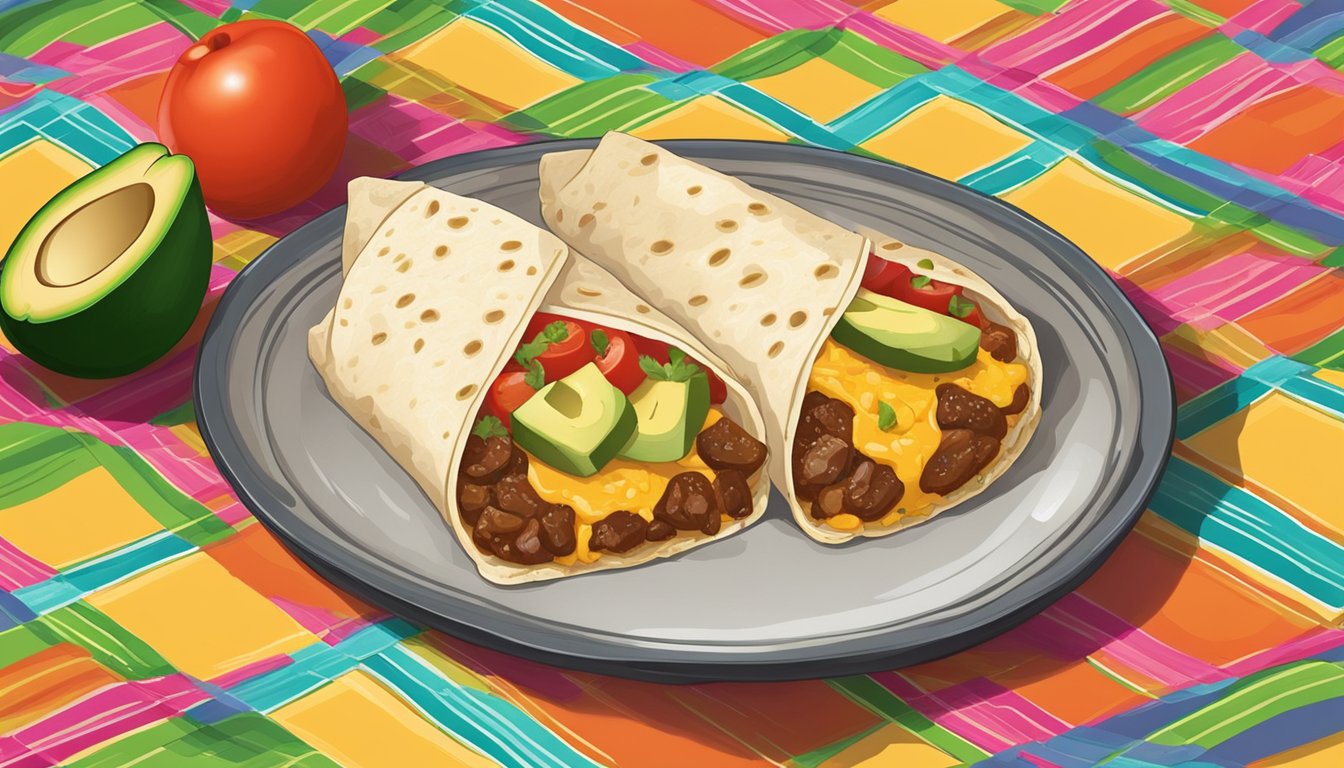Breakfast burritos have become a beloved morning staple across the United States, but their origins are often debated. While many assume these handheld meals are a traditional Mexican dish, the truth is more nuanced. Breakfast burritos as we know them today are primarily an American creation, influenced by Mexican cuisine but not a traditional Mexican breakfast item.
The concept of wrapping breakfast ingredients in a tortilla likely originated in the American Southwest, particularly in states like New Mexico and Texas. Restaurants like Tia Sophia’s in Santa Fe, New Mexico, played a significant role in popularizing breakfast burritos in the 1970s. These early versions combined classic American breakfast foods like eggs, bacon, and cheese with Mexican-inspired ingredients such as beans and salsa.
Modern breakfast burritos continue to evolve, incorporating a wide range of ingredients and flavors. While they may not be authentically Mexican, these hearty morning meals draw inspiration from Mexican culinary traditions and demonstrate the cultural fusion that often occurs in border regions and immigrant communities. The popularity of breakfast burritos has spread far beyond the Southwest, becoming a beloved breakfast option throughout the United States.
Origins and History

Breakfast burritos have a complex history rooted in Mexican culinary traditions and later adapted in the United States. Their evolution spans decades and reflects the blending of cultures and cuisines.
Mexican Cuisine Roots
Tortillas have been a staple in Mexican cuisine for centuries. The practice of wrapping ingredients in tortillas dates back to pre-Columbian times. This tradition laid the groundwork for what would eventually become the breakfast burrito.
In Mexico, similar dishes existed long before the term “breakfast burrito” was coined. Combinations of eggs, meats, and other fillings wrapped in tortillas were common morning meals in many Mexican households.
Adaptation and Evolution in the U.S.
The modern breakfast burrito emerged in the southwestern United States in the 1970s. New Mexico claims a significant role in its development. Tia Sophia’s, a diner in Santa Fe, reportedly first used the term “breakfast burrito” on their menu in 1975.
California also played a part in popularizing the dish. In the late 1970s and early 1980s, breakfast burritos gained traction in cities like San Diego and Los Angeles. Fast food chains began offering their versions in the late 1980s, with McDonald’s introducing their breakfast burrito nationwide.
The dish quickly spread across the country, becoming a beloved breakfast option. Today, breakfast burritos feature diverse ingredients and regional variations, reflecting local tastes and culinary influences.
Fundamental Ingredients

Breakfast burritos combine key components to create a satisfying and flavorful meal. The essential elements typically include protein-rich eggs, savory meats, fresh vegetables, and a sturdy tortilla wrap.
Eggs and Cheese
Eggs form the foundation of most breakfast burritos. Large eggs are scrambled until fluffy and often mixed with shredded cheddar cheese. The cheese melts into the warm eggs, creating a creamy texture and rich flavor. Some recipes call for adding milk or cream to the eggs for extra richness.
Salt and pepper are used to season the eggs, enhancing their natural taste. The egg and cheese mixture provides a protein-packed base that holds the other ingredients together.
Meats Variety
Breakfast burritos often feature a selection of meats. Popular choices include:
- Breakfast sausage
- Crispy bacon
- Ham
- Fresh chorizo
These meats add savory flavors and additional protein. Chorizo, a spicy Mexican sausage, brings a bold, zesty taste. Bacon provides a smoky crunch, while ham offers a milder flavor. Meats are typically cooked separately and then combined with other ingredients.
Fresh Vegetables and Herbs
Vegetables add color, texture, and nutrients to breakfast burritos. Common additions include:
- Diced onions
- Bell peppers
- Jalapenos for heat
- Diced tomatoes
Pico de gallo, a fresh salsa made with tomatoes, onions, cilantro, and lime juice, is a popular topping. It adds brightness and acidity to balance the rich ingredients.
Herbs like cilantro or parsley can be sprinkled in for added freshness and flavor.
Wraps and Tortillas
Flour tortillas are the most common wrap for breakfast burritos. They’re large enough to hold ample fillings and sturdy enough to prevent tearing. Some recipes use whole wheat or corn tortillas for variety.
Tortillas are often lightly warmed or grilled before filling to make them more pliable. This also helps them seal better when wrapped around the ingredients.
The size of the tortilla can vary, but 10-12 inch diameter is typical for a generously filled breakfast burrito.
Preparation and Cooking Techniques

Mastering key techniques ensures a delicious breakfast burrito. Proper egg scrambling, tortilla wrapping, and meat cooking form the foundation of this popular morning meal.
Crafting the Perfect Scrambled Eggs
Beat eggs with a splash of milk for fluffy texture. Heat a non-stick pan over medium-low heat. Add beaten eggs and gently stir with a spatula.
Cook slowly, folding eggs as they set. Remove from heat when slightly wet – they’ll continue cooking. Season with salt and pepper to taste.
For extra flavor, add shredded cheese or chopped herbs in the final moments of cooking. Avoid overcooking, as dry eggs can ruin the burrito’s texture.
Achieving the Ideal Wrap
Start with a large, room-temperature flour tortilla. Warm it briefly on a dry skillet to increase flexibility.
Place fillings in the center, leaving a border around the edges. Fold the bottom up and over the filling. Fold in both sides.
Roll tightly from the bottom up, tucking in the sides as you go. For a crispy exterior, place the wrapped burrito seam-side down on a hot griddle until golden.
Cooking Meat to Perfection
For bacon, cook in a skillet over medium heat until crisp. Drain on paper towels. Crumble or chop before adding to the burrito.
Brown chorizo in a pan, breaking it up with a spatula. Cook until fully done and slightly crispy. Drain excess fat before using.
For a leaner option, grill seasoned chicken breast until cooked through. Slice thinly against the grain.
Cook any meats separately from other ingredients to ensure proper doneness and to prevent flavors from overpowering the burrito.
Variations and Specialties

Breakfast burritos offer a wide range of regional styles, adaptable options for different dietary needs, and endless customization possibilities. These variations showcase the versatility of this popular morning meal.
Region-Specific Styles
New Mexico stands out for its unique breakfast burrito style. The state’s signature ingredient, New Mexico chile, adds a distinctive flavor and heat. These burritos often feature scrambled eggs, potatoes, and cheese wrapped in a flour tortilla, smothered in red or green chile sauce.
In California, breakfast burritos might include avocado slices or guacamole for a creamy texture. San Diego’s version typically incorporates french fries instead of traditional potatoes.
Texas-style breakfast burritos lean towards heartier fillings, often including refried beans and multiple meat options like bacon, sausage, and chorizo.
Vegetarian and Vegan Options
Vegetarian breakfast burritos replace meat with plant-based proteins. Common fillings include:
- Black beans or pinto beans
- Tofu scramble
- Roasted vegetables
Vegan versions go a step further, using dairy-free cheese alternatives and omitting eggs. Avocado often serves as a creamy substitute for cheese or sour cream.
Some recipes incorporate nutritional yeast for a cheesy flavor without dairy. Scrambled tofu seasoned with turmeric mimics the look and texture of eggs.
Customization Ideas
Breakfast burritos are highly customizable. Popular additions include:
- Hash browns or tater tots for extra crunch
- Sour cream for tanginess
- Salsa or pico de gallo for freshness
- Jalapeños or hot sauce for heat
Make-ahead breakfast burritos offer convenience. These can be prepared in batches, wrapped individually, and frozen. Reheating in a microwave or oven provides a quick, satisfying breakfast.
Some prefer “deconstructed” breakfast burritos, serving ingredients in a bowl with tortillas on the side. This allows diners to create their own perfect bites.
Serving and Accompaniments

Breakfast burritos are often enhanced by a variety of condiments and side dishes. These additions can complement the flavors and textures of the burrito, creating a more satisfying meal.
Classic Condiments
Salsa is a staple accompaniment for breakfast burritos. Fresh pico de gallo, made with diced tomatoes, onions, cilantro, and lime juice, adds a bright, zesty flavor. Hot sauce enthusiasts may prefer a spicier kick, with options ranging from mild to fiery.
Sour cream provides a cool, creamy contrast to the savory burrito filling. It can be dolloped on top or served on the side for dipping. Some diners enjoy mixing salsa and sour cream to create a tangy, spicy sauce.
Side Dishes
Potatoes often feature as a popular side dish for breakfast burritos. Hash browns or home fries offer a crispy texture that complements the soft burrito wrapper. These can be seasoned with simple salt and pepper or spiced up with chili powder and garlic for added flavor.
Mexican-inspired sides like refried beans or black beans provide extra protein and fiber. A small portion of Mexican rice can round out the meal. For a lighter option, a fresh fruit salad or sliced avocado can balance the heartier components of the breakfast burrito.
Nutrition and Dietary Considerations

Breakfast burritos offer a mix of nutrients but vary widely in their caloric and macronutrient content. The nutritional profile depends largely on ingredients and portion size.
Caloric Content
A typical breakfast burrito contains between 300-800 calories. Smaller, simpler versions may have around 300 calories, while larger, ingredient-packed burritos can reach 800 calories or more.
Restaurant versions tend to be higher in calories. For example, some Mexican breakfast burritos contain up to 1177 calories per serving.
Homemade burritos allow for better calorie control. Choosing lean proteins, whole grain tortillas, and limiting high-calorie additions like cheese and sour cream can reduce the overall calorie count.
Macronutrient Balance
The macronutrient composition of breakfast burritos varies based on ingredients. A balanced burrito typically contains:
- Carbohydrates: 25-57% of total calories
- Protein: 18-39% of total calories
- Fat: 25-55% of total calories
Eggs provide high-quality protein, while beans offer both protein and fiber. Cheese adds protein and fat. Tortillas contribute carbohydrates.
To improve the macronutrient balance, consider:
- Using whole grain tortillas for added fiber
- Incorporating more vegetables for nutrients and fiber
- Choosing lean meats or plant-based proteins
Gluten-Free and Dairy-Free Options
Breakfast burritos can be adapted for various dietary needs. For gluten-free options, use corn tortillas instead of wheat-based ones. Ensure all other ingredients are gluten-free.
For dairy-free burritos:
- Omit cheese and sour cream
- Use plant-based alternatives like avocado for creaminess
- Add nutritional yeast for a cheese-like flavor
These modifications allow those with dietary restrictions to enjoy breakfast burritos while meeting their nutritional needs. Beans, eggs, and vegetables can still provide ample protein and nutrients in dairy-free versions.
Cultural Significance

Breakfast burritos have transcended their humble origins to become a cultural phenomenon. They represent a fusion of Mexican and American culinary traditions, gaining popularity across diverse communities.
From Street Food to Gourmet
Breakfast burritos began as simple street food in Mexico and the southwestern United States. Over time, they evolved into a versatile dish found in both casual eateries and upscale restaurants. Food trucks played a crucial role in popularizing breakfast burritos, making them accessible to urban dwellers and office workers.
Chefs have embraced the breakfast burrito, creating gourmet versions with high-end ingredients. Some restaurants offer build-your-own options, allowing customers to customize their burritos. This adaptability has contributed to the breakfast burrito’s widespread appeal.
Representation in Media and Popular Culture
Breakfast burritos have become a staple in pop culture, appearing in movies, TV shows, and social media. They are often portrayed as a quick, satisfying meal for characters on the go. Food bloggers and influencers regularly feature breakfast burritos in their content, showcasing creative recipes and local hotspots.
The dish has also gained attention in health and fitness circles. Nutritionists discuss ways to make healthier breakfast burritos, while athletes share them as part of their meal plans. This media presence has further cemented the breakfast burrito’s place in contemporary food culture.
Recipe and Preparation Tips
Crafting a delicious breakfast burrito requires careful attention to ingredients and technique. The following guide provides a step-by-step recipe and expert tips to elevate your breakfast burrito game.
Step-by-Step Breakfast Burrito Recipe
Start by cooking diced potatoes in a skillet until crispy. In a separate pan, scramble eggs with a splash of milk for fluffiness. Cook bacon or chorizo until crisp, then crumble. Warm large flour tortillas on a griddle.
Layer the tortilla with scrambled eggs, potatoes, meat, shredded cheese, and diced bell peppers. Add a sprinkle of garlic powder for extra flavor. Roll the burrito tightly, tucking in the sides.
For a finishing touch, briefly grill the burrito seam-side down to seal it. Serve immediately with salsa or hot sauce on the side.
Expert Tips for the Best Breakfast Burrito
Use fresh ingredients for optimal flavor. Opt for high-quality tortillas that won’t tear easily. Pre-cook and season the potatoes for a crispy texture.
Avoid overfilling the burrito to prevent splitting. Let ingredients cool slightly before assembly to prevent sogginess. For meal prep, wrap burritos in foil and freeze for up to a month.
Experiment with different cheeses like pepper jack or cheddar. Add avocado or guacamole for creaminess. For a healthier option, use whole wheat tortillas and turkey bacon.
Heat the tortillas before filling to improve flexibility and prevent cracking. Serve with a variety of toppings like sour cream, pico de gallo, or sliced jalapeños.
Conclusion

Breakfast burritos represent a fusion of Mexican and American culinary traditions. While their core concept draws inspiration from Mexican cuisine, they evolved into a distinct dish in the United States.
The breakfast burrito’s origins can be traced to the southwestern United States, particularly California and New Mexico, in the 1970s. It emerged as a creative adaptation of traditional Mexican ingredients and American breakfast foods.
Tia Sophia’s, a diner in Santa Fe, claims to have first used the term “breakfast burrito” on a menu in 1975. However, similar dishes likely existed in New Mexican cuisine before this formal naming.
The popularity of breakfast burritos grew rapidly, spreading across the country. Fast food chains like McDonald’s introduced their versions in the late 1980s, further cementing the dish’s place in American breakfast culture.
Today, breakfast burritos are widely recognized as an American creation, despite their Mexican-inspired roots. They showcase the dynamic nature of culinary evolution and cultural exchange in the United States.




